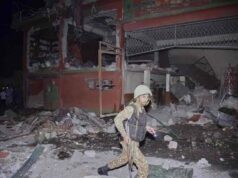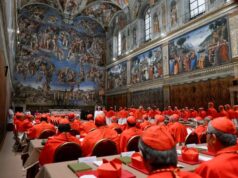Today after the press conference of the 4 Judges on the dispute with the Chief Justice of India, D Raja met the Justice Chelameswar, which created a big political controversey. Arnab Goswami invited D Raja on the debate, he completely Demolished And EXPOSED D Raja And Congress And Made Him Walk Out of the show. (Watch the video at the bottom of the article)
Raja met Chelameshwar after the press conference.
“[I] have known him for a long time,” Raja said. “When I came to know of the extraordinary step taken by him and other judges, I thought I must meet him. Not giving it political colour.” He added that Chelameswar did not reveal any information to him apart from what was said at the press conference.
Earlier, In an unprecedented move, four judges from India’s Supreme Court held a press conference on Friday to air their unhappiness over the way the Chief Justice of India, Dipak Misra, allocates cases to other judges.
This is the first time in the country’s independent history that sitting judges from the apex court have openly spoken out against a Chief Justice.
While three of the four judges – Justice Jasti Chelameswar, Justice Madan Lokur and Justice Kurien Joseph – are due to retire later this year, Justice Ranjan Gogoi is slated to be the next Chief Justice of India. This makes the judges’ public dissent even more serious.
The judiciary, along with the legislature and executive, is one of the three pillars that upholds India’s democracy, as enshrined by the Constitution. Each is supposed to function independently of the others to provide checks and balances in the constitutional scheme of things.
According to convention, the Chief Justice of India is the master of the Supreme Court roster and he or she decides on the allotment of cases to judges. This serves only to recognize the privilege of the head judge for an efficient functioning of the court, and is not a recognition of any superior power over the other judges of the court. Because, according to settled tenets of jurisprudence, the Chief Justice is only the first among equals in respect of the other judges of the Supreme Court.
Senior Advocate Indira Jaising lauded the dissenting judges for voicing their concerns. “It will be significantly beneficial for the judiciary’s institutional integrity, as well as that of the country,” she said. “The very fact that four senior-most judges have come out in the public is akin to a full bench of the Supreme Court openly stating that something is rotten in the system and urgent remedial measures needed to be taken”.
Conflict of interest alleged
Tension has been brewing among the judiciary since November last year.
On November 8, a two-judge bench headed by Justice Chelameswar had ordered the setting up of a five-judge constitutional bench to hear a sensitive matter related to corruption in the judiciary.
The two-judge bench order after a petition filed by a non-profit, the Centre for Judicial Accountability and Reforms (CJAR). The petition sought a probe into allegations of bribery over affiliating medical colleges by the Medical Council of India. The Centre’s petition alleged that medical colleges had obtained favorable orders from the courts by bribing senior judges.
These allegations were also targeted at Chief Justice Misra, who had heard the case earlier. The petition argued that Chief Justice Misra should recuse himself from hearing the petition because there was a conflict of interest. Justice Chelameswar passed an order saying that the case must be heard by five of the senior-most judges of the Supreme Court – and not the Chief Justice.
But before the case could be heard, Chief Justice Misra set up a separate five-judge bench on November 9 and overturned Justice Chelameswar’s order. This move drew widespread criticism, with many legal luminaries claiming the judicial process had been grossly violated.
A day before this contentious judgment, Chief Justice Misra headed a bench of three judges that passed another controversial judgment. Known as the R P Luthra Vs Union of India, the case involved finalizing a method to appoint High Court and Supreme Court judges. Currently, judges to the highest courts in India are appointed by the Supreme Court’s five seniormost judges. This issue has been debated between the government and the judiciary since 2015.
The government wanted to play a role in the appointment of judges but the judiciary argued that this would erode their independence. The judges also noted that the Constitution wants the three branches of government to be separate and independent.
The case was heard by a two-judge bench in October last year. It ruled that the matter needs to be dealt judicially. In a contentious move, Chief Justice Misra set up a three-judge panel less than a month later and recalled the order, which sparked the current crisis.
In their letter to the Chief Justice, the four judges slammed this move. They said he “should not have arrogated the power to himself and picked a bench of his preference”. Instead, he should have “allowed the matter to be decided appropriately by no other than a Constitution Bench of five judges or more”. Basically, the judges alleged that Misra’s decisions were undermining the sanctity of well-established “judicial conventions”.
Death of judge hearing case linked to ruling party
Another matter that came up during the press conference also has the potential for major political fallout. The Supreme Court is also meant to hear a petition seeking an independent probe into the death of a trial judge three years ago. The judge, BH Loya, was hearing a controversial case of an alleged staged encounter by the Gujarat police when Narendra Modi was the chief minister of the state. Amit Shah, the current president of the ruling Bharatiya Janata Party, was the state’s home minister, and therefore became an accused in the case.
It has been alleged that Loya died under mysterious circumstances and his family has been seeking a probe since then. There is no direct reference to this case in the letter from the four dissenting judges. But when reporters asked if the press conference was also related to Loya’s death, Justice Gogoi replied “Yes”.
As soon as the press conference was over, there were reports suggesting that Prime Minister Modi had called in the union law minister, Ravishankar Prasad and his deputy PP Chaudhri. It is not known what they discussed, but this appears to be a highly sensitive matter for the government.
Rebecca John, a noted criminal lawyer and a Senior Advocate, told Asia Times: “I find these politically correct responses, to what is clearly an unprecedented crisis, quite tiresome. I too wish it hadn’t come to this. I wish, they could have set their house in order by talking to each other and taking correctional measures. I wish there was no press conference. But sometimes you need to come out, when nothing else works. A democracy functions in open spaces, not behind opaque doors. And the problem facing the judiciary today is very very serious. It’s about institutional integrity. Recognise it.”
Clearly, India’s highest judicial body is in for a stormy session that could also spark off a major political crisis.




